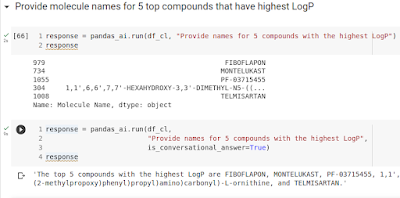ChatGPT will bring revolution to knowledge management and insight generation. Are we ready for this?
I have never done a cyclic peptide design in my life. So,
when I was approached with a question on how to optimize the permeability of
one, I guessed that more lipophilicity would help, and likely there are some
specific neutral "vectors" that will also help. But the usual step is to go
thru several papers and get the answer, obvious, right? I started with a very good article: "Optimizing
PK properties of cyclic peptides: the effect of side chain substitutions on
permeability and clearance". Read it, made conclusions and decided to feed it to
ChatGPT (3.5) with request to "please extract very concise medicinal chemistry insights that can be further reused for peptide optimization". Here is what I got and and that was very neat:
1. Modification of peptide side chains significantly alters their log D values and subsequently their in vitro properties. For instance, aromatic or polar aliphatic side chains didn't significantly reduce log D, whereas ionizable aspartic acid and lysine side chains did, but at the cost of permeability.
2. Non-natural N-methylated amino acids with heterocyclic side chains demonstrated favorable log D's and low clearance.
3. There's a correlation between
log D and permeability, as well as log D and clearance. A log D value around
three seems optimal for both permeability and clearance.
4. The oral bioavailability (F) of
peptides can be significantly affected by their polarity and permeability. For
example, peptide 2 had a significantly lower F than peptide 1 due to its
greater polarity and lower permeability.
5. Some peptides, despite having
low clearance, still demonstrated low oral bioavailability, suggesting that
poor absorptive permeability can limit oral absorption.
6. Oral absorption of peptides
might be improved through solubilizing formulations.
7. The introduction of polar groups
into the peptide scaffold impacts structural diversity and property space,
which is essential for the design of cyclic peptide-based therapeutics.
8. Substitution of certain amino
acids could drastically affect the cell permeability and oral bioavailability,
e.g., substitution of Leu with Ser significantly reduced both.
With the era of LLMs information processing changed forever. Large language models (LLMs) have a massive potential for knowledge management and insight generation. We cannot process the amount of data we are generating. We need to act on data fast. And adoption of them by pharmaceutical and biotech industries is slow because of the challenges that just became obvious: the cost of supporting those models is huge, the expertise gap is there, and data quality still suboptimal. Most common tasks are:
- Identifying unusual patterns: "Company XYZ started hiring senior PK/PD people for therapeutic area V, which might impact project T. Consider increase budgeting for project T in preclinical stages."
- Connecting A and B: "Phenotypic project X has similar hits as phenotypic project Y, likely they are connected via pathway Z and downregulating target A, B, and C. Consider merging assets of those projects together."
- Summarizing knowledge into a machine-readable and actionable form that, in turn, will help generative models to improve: "Generation of the new set of compounds for hit series of project V finished. We have used insights from several references that indicate that the efficiency of a hit will likely increase if we increase logD by one unit and keep HBD between 3 and 5 for this therapeutic area. Those compounds are prone to Nav1.5-related cardiotoxicity, as indicated by publications [12-19] and confirmed by internal models.
PS: feeding the link didn't work in ChatGPT even with plugins, so I removed experimental part and tables.


Comments
Post a Comment